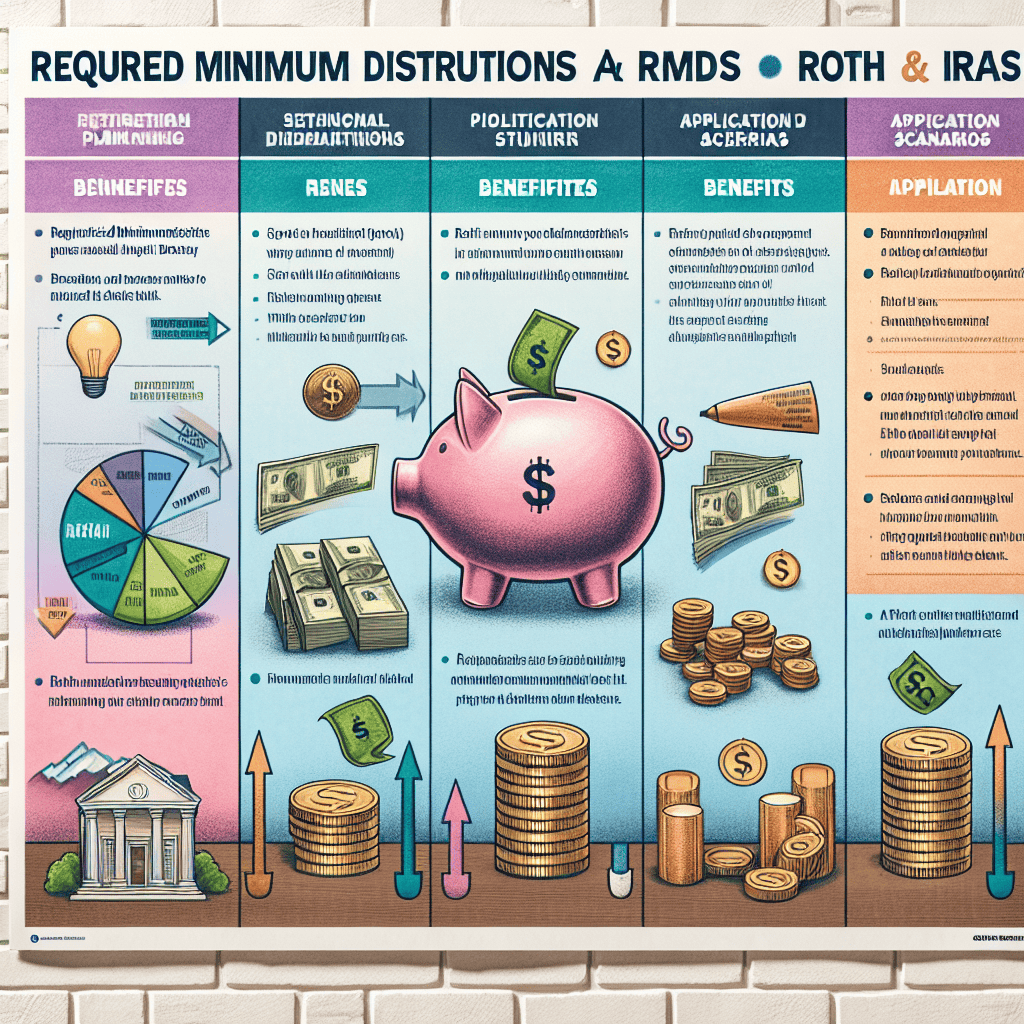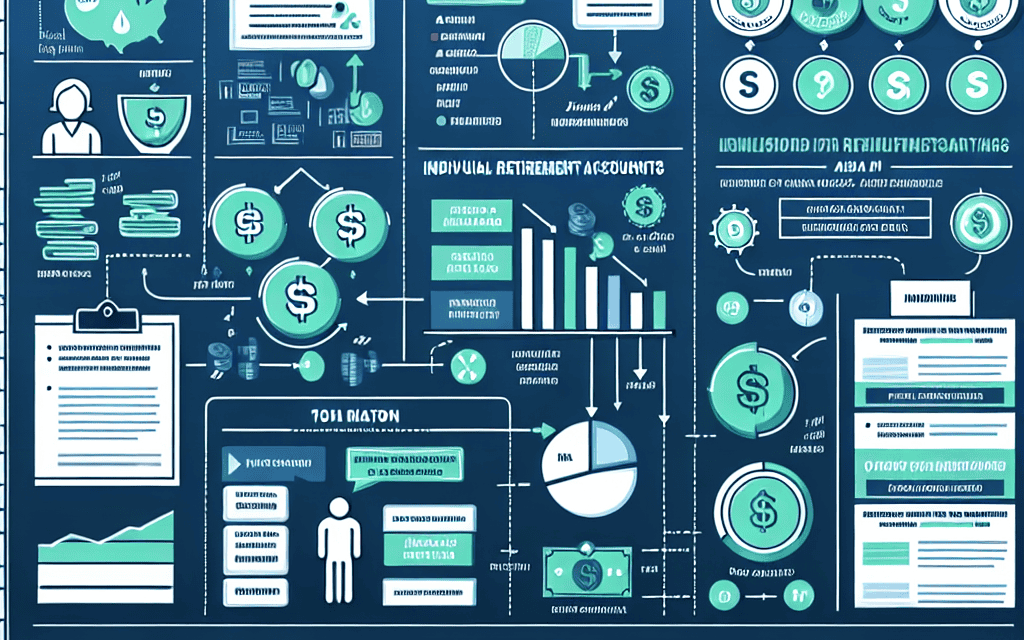“Master Your Retirement: Unlocking the Secrets of RMDs and Roth IRAs”
Introduction
Understanding Required Minimum Distributions (RMDs) and Roth Individual Retirement Accounts (IRAs) is crucial for effective retirement planning. RMDs are mandatory withdrawals that individuals must take from their traditional IRAs and employer-sponsored retirement plans once they reach a certain age, typically 72, to ensure that the government can tax these funds. On the other hand, Roth IRAs offer a unique advantage: contributions are made with after-tax dollars, allowing for tax-free growth and withdrawals in retirement, and they are not subject to RMDs during the account holder’s lifetime. This distinction makes Roth IRAs an attractive option for those seeking flexibility and tax efficiency in their retirement strategy. Understanding the nuances of RMDs and Roth IRAs can help individuals make informed decisions to optimize their retirement savings and minimize tax liabilities.
Differences Between RMDs and Roth IRAs
Understanding the differences between Required Minimum Distributions (RMDs) and Roth Individual Retirement Accounts (IRAs) is crucial for anyone planning their retirement strategy. Both RMDs and Roth IRAs play significant roles in retirement planning, yet they serve distinct purposes and have unique characteristics that can impact financial decisions. To begin with, RMDs are mandatory withdrawals that individuals must take from their traditional IRAs, 401(k)s, and other retirement accounts once they reach a certain age, currently set at 73 as of 2023. The primary purpose of RMDs is to ensure that individuals do not defer taxes indefinitely on their retirement savings. In contrast, Roth IRAs offer a different approach to retirement savings, where contributions are made with after-tax dollars, allowing for tax-free growth and withdrawals, provided certain conditions are met.
One of the most notable differences between RMDs and Roth IRAs is the tax treatment. With traditional IRAs and other retirement accounts subject to RMDs, contributions are typically made with pre-tax dollars, meaning taxes are deferred until withdrawals are made. This results in taxable income during retirement, which can affect one’s overall tax bracket. On the other hand, Roth IRAs provide a tax advantage by allowing tax-free withdrawals, as taxes have already been paid on the contributions. This feature can be particularly beneficial for individuals who anticipate being in a higher tax bracket during retirement or who wish to minimize their taxable income in their later years.
Another key distinction lies in the withdrawal requirements. RMDs are obligatory, and failing to take them can result in significant penalties, specifically a 50% excise tax on the amount that should have been withdrawn. This requirement can sometimes force retirees to take out more money than they need, potentially impacting their financial planning. Conversely, Roth IRAs do not have RMDs during the account holder’s lifetime, providing greater flexibility in managing withdrawals. This absence of mandatory distributions allows individuals to let their investments grow tax-free for a longer period, which can be advantageous for estate planning purposes.
Furthermore, the differences extend to the impact on beneficiaries. Upon the account holder’s death, beneficiaries of traditional IRAs are required to take RMDs, which can affect their tax situation. In contrast, beneficiaries of Roth IRAs can continue to enjoy tax-free growth and withdrawals, although they are subject to certain distribution rules. This aspect makes Roth IRAs an attractive option for those looking to pass on wealth to their heirs in a tax-efficient manner.
In addition to these differences, it is important to consider the strategic implications of each option. For instance, individuals who expect to have lower income in retirement might benefit more from traditional IRAs and the tax deferral they offer. Meanwhile, those who prioritize tax-free income and estate planning might find Roth IRAs more appealing. Ultimately, understanding the nuances between RMDs and Roth IRAs can help individuals make informed decisions that align with their financial goals and retirement plans.
In conclusion, while both RMDs and Roth IRAs are integral components of retirement planning, they serve different functions and offer distinct advantages. By recognizing these differences, individuals can better navigate their retirement strategies, ensuring they maximize their savings and minimize their tax liabilities. As with any financial decision, consulting with a financial advisor can provide personalized guidance tailored to one’s unique circumstances and objectives.
Tax Implications of RMDs and Roth IRAs
When planning for retirement, understanding the tax implications of Required Minimum Distributions (RMDs) and Roth IRAs is crucial for effective financial management. RMDs are mandatory withdrawals that individuals must take from their traditional IRAs, 401(k)s, and other qualified retirement plans once they reach a certain age, currently set at 73 as of 2023. These distributions are designed to ensure that individuals do not defer taxes indefinitely. On the other hand, Roth IRAs offer a different tax structure, where contributions are made with after-tax dollars, allowing for tax-free withdrawals in retirement. The interplay between these two retirement vehicles can significantly impact one’s tax strategy.
To begin with, RMDs are subject to ordinary income tax, which can potentially push retirees into a higher tax bracket, especially if they have other sources of income. This increase in taxable income can also affect the taxation of Social Security benefits and the cost of Medicare premiums. Therefore, it is essential for retirees to plan their withdrawals carefully to minimize the tax burden. One strategy to consider is the timing of RMDs. By strategically withdrawing funds in years when one’s income is lower, it is possible to reduce the overall tax impact. Additionally, individuals can explore the option of converting traditional IRAs to Roth IRAs before reaching the age for RMDs, thereby potentially lowering future RMD amounts and associated taxes.
Conversely, Roth IRAs provide a unique advantage in retirement planning due to their tax-free growth and withdrawals. Since contributions to Roth IRAs are made with after-tax dollars, the account holder does not face any tax liability upon withdrawal, provided certain conditions are met. This feature makes Roth IRAs an attractive option for those who anticipate being in a higher tax bracket during retirement. Moreover, Roth IRAs are not subject to RMDs during the account holder’s lifetime, allowing for greater flexibility in managing retirement funds. This absence of mandatory withdrawals can be particularly beneficial for individuals who do not need to access their retirement savings immediately and prefer to let their investments grow tax-free.
However, it is important to note that while Roth IRAs offer significant tax advantages, they also come with contribution limits and eligibility requirements based on income. Therefore, individuals should assess their financial situation and consult with a financial advisor to determine the most suitable retirement strategy. Additionally, converting a traditional IRA to a Roth IRA involves paying taxes on the converted amount, which can be a substantial cost upfront. Thus, careful consideration and planning are necessary to ensure that the benefits of conversion outweigh the immediate tax implications.
In conclusion, understanding the tax implications of RMDs and Roth IRAs is essential for effective retirement planning. While RMDs can increase taxable income and potentially lead to higher taxes, strategic planning and Roth IRA conversions can mitigate these effects. Meanwhile, Roth IRAs offer tax-free growth and withdrawals, providing a valuable tool for managing retirement funds. By carefully evaluating their financial situation and considering the long-term tax implications, individuals can make informed decisions that align with their retirement goals. Ultimately, a well-thought-out strategy can help retirees maximize their savings and minimize their tax liabilities, ensuring a more secure and comfortable retirement.
Strategies for Managing RMDs in Retirement
As individuals approach retirement, understanding the intricacies of Required Minimum Distributions (RMDs) and Roth IRAs becomes crucial for effective financial planning. RMDs are mandatory withdrawals that must be taken from traditional IRAs and employer-sponsored retirement plans once the account holder reaches a certain age, currently set at 73. These distributions are designed to ensure that individuals do not defer taxation indefinitely. However, managing RMDs strategically can significantly impact one’s financial well-being in retirement.
One effective strategy for managing RMDs is to begin planning well before reaching the age at which they become mandatory. By doing so, retirees can mitigate the potential tax implications associated with large distributions. For instance, converting a portion of a traditional IRA to a Roth IRA before RMDs begin can be advantageous. Although the conversion itself is a taxable event, it allows future growth to occur in a Roth IRA, which is not subject to RMDs and can be withdrawn tax-free, provided certain conditions are met. This approach not only reduces the size of future RMDs but also offers tax diversification in retirement.
Moreover, understanding the timing of RMDs is essential. While the first RMD can be delayed until April 1 of the year following the year in which the account holder turns 73, subsequent RMDs must be taken by December 31 each year. Delaying the first RMD may result in two distributions in one year, potentially pushing the retiree into a higher tax bracket. Therefore, careful consideration of the timing and amount of withdrawals can help manage tax liabilities effectively.
In addition to timing, retirees should consider the impact of RMDs on their overall investment strategy. Since RMDs are calculated based on the account balance and life expectancy, market fluctuations can influence the amount required to be withdrawn. To address this, retirees might adopt a diversified investment approach that balances growth and income, thereby stabilizing the account balance and minimizing the impact of market volatility on RMD calculations.
Furthermore, for those who do not need the RMD for living expenses, reinvesting the distribution into a taxable brokerage account can be a prudent move. This strategy allows the funds to continue growing, albeit in a taxable environment, and can be tailored to align with the retiree’s risk tolerance and financial goals. Additionally, retirees might consider using RMDs for charitable purposes. By directing RMDs to a qualified charity through a Qualified Charitable Distribution (QCD), individuals can satisfy their RMD requirement while excluding the distribution from taxable income, thus achieving both philanthropic and tax-saving objectives.
Lastly, it is important to regularly review and adjust one’s retirement strategy in response to changes in tax laws and personal circumstances. Consulting with a financial advisor can provide valuable insights and help retirees navigate the complexities of RMDs and Roth IRAs. By staying informed and proactive, retirees can optimize their retirement income, minimize tax burdens, and ensure a more secure financial future.
In conclusion, managing RMDs in retirement requires a comprehensive understanding of the rules and strategic planning. By considering Roth IRA conversions, timing withdrawals carefully, diversifying investments, reinvesting distributions, and exploring charitable options, retirees can effectively manage their RMDs and enhance their financial security. Through thoughtful planning and professional guidance, individuals can navigate the complexities of retirement distributions and achieve their long-term financial goals.
Benefits of Roth IRAs for Long-Term Savings

Roth Individual Retirement Accounts (IRAs) have become an increasingly popular choice for long-term savings, offering a range of benefits that can significantly enhance one’s financial strategy. Understanding the advantages of Roth IRAs, particularly in the context of Required Minimum Distributions (RMDs), is crucial for anyone looking to optimize their retirement planning. Unlike traditional IRAs, Roth IRAs provide a unique opportunity for tax-free growth and withdrawals, which can be particularly advantageous in the long run.
One of the most compelling benefits of a Roth IRA is the tax-free growth it offers. Contributions to a Roth IRA are made with after-tax dollars, meaning that the money has already been taxed before it is deposited into the account. As a result, the investments within the Roth IRA grow tax-free, and qualified withdrawals during retirement are also tax-free. This feature can be especially beneficial for individuals who anticipate being in a higher tax bracket during retirement, as it allows them to avoid paying taxes on their investment gains at that time.
In addition to tax-free growth, Roth IRAs offer flexibility that is not available with traditional IRAs. For instance, Roth IRAs do not have RMDs during the account holder’s lifetime. This means that individuals are not required to withdraw a certain amount of money each year after reaching a specific age, as is the case with traditional IRAs. The absence of RMDs allows account holders to let their investments continue to grow tax-free for as long as they wish, providing greater control over their retirement funds. This can be particularly advantageous for those who do not need to rely on their retirement savings for immediate income and prefer to leave their investments untouched for as long as possible.
Moreover, Roth IRAs offer significant estate planning benefits. Since there are no RMDs, account holders can pass on the full value of their Roth IRA to their beneficiaries, who can then enjoy tax-free withdrawals over their lifetimes. This feature makes Roth IRAs an attractive option for individuals looking to leave a financial legacy for their heirs. Additionally, the ability to withdraw contributions at any time without penalties or taxes provides a level of liquidity that can be useful in case of emergencies or unexpected expenses.
Furthermore, Roth IRAs can serve as a hedge against future tax rate increases. Given the uncertainty surrounding future tax policies, having a portion of retirement savings in a Roth IRA can provide a measure of protection against potential tax hikes. By paying taxes on contributions now, account holders can safeguard their future withdrawals from being subject to higher tax rates, thus preserving more of their savings for retirement.
In conclusion, the benefits of Roth IRAs for long-term savings are manifold, offering tax-free growth, flexibility, and estate planning advantages that are not available with traditional IRAs. The absence of RMDs allows for greater control over retirement funds, while the potential for tax-free withdrawals provides a strategic advantage in managing future tax liabilities. As individuals plan for their financial futures, considering the unique features of Roth IRAs can be a prudent step in ensuring a secure and prosperous retirement.
How to Convert Traditional IRAs to Roth IRAs
Converting a Traditional IRA to a Roth IRA is a strategic financial decision that can offer significant tax advantages, but it requires careful consideration and planning. Understanding the nuances of this conversion process is essential for individuals seeking to optimize their retirement savings. The primary motivation for converting a Traditional IRA to a Roth IRA is the potential for tax-free growth and withdrawals. Unlike Traditional IRAs, Roth IRAs allow for tax-free withdrawals in retirement, provided certain conditions are met. This can be particularly advantageous for individuals who anticipate being in a higher tax bracket during retirement or who wish to minimize their taxable income in later years.
The conversion process involves transferring funds from a Traditional IRA to a Roth IRA, which triggers a taxable event. The amount converted is added to the individual’s taxable income for the year, potentially pushing them into a higher tax bracket. Therefore, it is crucial to evaluate one’s current and projected future tax situations before proceeding. To mitigate the tax impact, some individuals choose to convert portions of their Traditional IRA over several years, a strategy known as a partial conversion. This approach allows for more control over the tax implications and can prevent a significant spike in taxable income in any given year.
Moreover, it is important to consider the timing of the conversion. Converting during a year when one’s income is lower than usual can be beneficial, as it may result in a lower overall tax liability. Additionally, market conditions can influence the decision; converting when the market is down may reduce the taxable amount, as the value of the assets being converted is lower. However, it is essential to weigh these factors against the potential for market recovery and growth within the Roth IRA.
Another critical aspect to consider is the five-year rule associated with Roth IRAs. This rule stipulates that for the earnings on contributions to be tax-free, the Roth IRA must be held for at least five years. This period begins on January 1 of the year in which the first contribution or conversion is made. Therefore, individuals close to retirement should carefully assess whether they will meet this requirement before needing to access the funds.
Furthermore, individuals should be aware of the impact on Required Minimum Distributions (RMDs). Traditional IRAs mandate RMDs starting at age 72, which can increase taxable income in retirement. In contrast, Roth IRAs do not require RMDs during the account holder’s lifetime, allowing for greater flexibility in managing retirement income and potentially leaving a larger inheritance to beneficiaries.
In conclusion, converting a Traditional IRA to a Roth IRA can be a valuable strategy for those seeking tax-free growth and withdrawals in retirement. However, it requires a thorough analysis of one’s current and future financial situation, tax implications, and retirement goals. Consulting with a financial advisor or tax professional can provide personalized guidance and ensure that the conversion aligns with one’s overall retirement strategy. By carefully considering these factors, individuals can make informed decisions that enhance their financial security in retirement.
Common Mistakes to Avoid with RMDs
When it comes to managing retirement accounts, understanding the nuances of Required Minimum Distributions (RMDs) and Roth IRAs is crucial for ensuring financial stability in one’s later years. However, navigating these financial instruments can be fraught with potential pitfalls. One common mistake individuals make with RMDs is failing to take the distribution by the required deadline. The Internal Revenue Service mandates that RMDs must be taken by December 31 each year, starting the year after you turn 72. Missing this deadline can result in a hefty penalty, amounting to 50% of the amount that should have been withdrawn. Therefore, it is essential to mark your calendar and plan accordingly to avoid this costly oversight.
Another frequent error involves miscalculating the RMD amount. The calculation is based on the account balance as of December 31 of the previous year and a life expectancy factor provided by the IRS. Missteps in this calculation can lead to either withdrawing too little, which incurs penalties, or withdrawing too much, which could unnecessarily increase your taxable income. To prevent such errors, it is advisable to consult with a financial advisor or use the IRS-provided worksheets to ensure accuracy.
Moreover, some individuals mistakenly believe that RMDs apply to Roth IRAs in the same way they do to traditional IRAs. In reality, Roth IRAs do not require RMDs during the account holder’s lifetime, which is a significant advantage for those looking to minimize taxable income in retirement. This misunderstanding can lead to unnecessary withdrawals from a Roth IRA, potentially disrupting a well-planned retirement strategy. Therefore, it is important to distinguish between the rules governing traditional IRAs and Roth IRAs to optimize your retirement savings.
Additionally, failing to consolidate multiple retirement accounts can complicate the RMD process. Many retirees have several accounts from different employers or financial institutions, which can make tracking and managing RMDs cumbersome. By consolidating these accounts, you can simplify the process, reduce the risk of errors, and potentially lower administrative fees. This consolidation can also provide a clearer picture of your overall financial situation, aiding in more effective retirement planning.
Furthermore, overlooking the tax implications of RMDs is another common mistake. Since RMDs from traditional IRAs are considered taxable income, they can push you into a higher tax bracket, affecting not only your federal taxes but also your state taxes and Medicare premiums. To mitigate this impact, consider strategies such as charitable distributions, which allow you to donate your RMD directly to a qualified charity, thereby excluding it from your taxable income.
Lastly, neglecting to update beneficiary designations can lead to unintended consequences for your heirs. Life changes such as marriage, divorce, or the birth of a child necessitate revisiting and potentially revising these designations. Failing to do so can result in assets being distributed in a manner inconsistent with your current wishes, causing potential financial and emotional strain for your loved ones.
In conclusion, while managing RMDs and Roth IRAs can be complex, being aware of these common mistakes and taking proactive steps to avoid them can help ensure a more secure and efficient retirement. By staying informed and seeking professional guidance when necessary, you can navigate these financial waters with confidence and peace of mind.
Planning for RMDs and Roth IRAs in Estate Planning
In the realm of estate planning, understanding the nuances of Required Minimum Distributions (RMDs) and Roth Individual Retirement Accounts (IRAs) is crucial for ensuring a well-structured financial future. As individuals approach retirement, the interplay between these two financial instruments can significantly impact the distribution of assets and the overall tax implications for both the account holder and their beneficiaries. Therefore, a comprehensive grasp of how RMDs and Roth IRAs function within estate planning is essential for making informed decisions.
To begin with, Required Minimum Distributions are mandatory withdrawals that individuals must start taking from their traditional IRAs and employer-sponsored retirement plans, such as 401(k)s, once they reach a certain age. As of 2023, the age at which RMDs must commence is 73, following recent legislative changes. The primary purpose of RMDs is to ensure that individuals do not defer taxes indefinitely on their retirement savings. Consequently, the amount of the RMD is calculated based on the account balance at the end of the previous year and the account holder’s life expectancy, as determined by IRS tables. Failing to take the required distribution can result in substantial penalties, making it imperative for retirees to plan accordingly.
In contrast, Roth IRAs offer a different set of advantages and considerations. Contributions to Roth IRAs are made with after-tax dollars, meaning that withdrawals, including earnings, are generally tax-free, provided certain conditions are met. This tax-free growth and distribution feature makes Roth IRAs an attractive option for estate planning, as they can provide beneficiaries with a source of tax-free income. Moreover, unlike traditional IRAs, Roth IRAs do not have RMDs during the account holder’s lifetime, allowing the funds to grow tax-free for a more extended period. This characteristic can be particularly beneficial for individuals who do not need to access their retirement savings immediately and wish to leave a more substantial legacy to their heirs.
When integrating RMDs and Roth IRAs into an estate plan, several strategic considerations come into play. For instance, individuals may choose to convert traditional IRA assets to a Roth IRA, a process known as a Roth conversion. This strategy can be advantageous for those who anticipate being in a higher tax bracket in the future or who wish to minimize the tax burden on their beneficiaries. However, it is essential to weigh the immediate tax implications of a Roth conversion, as the converted amount is subject to income tax in the year of conversion.
Furthermore, understanding the beneficiary designations for both RMDs and Roth IRAs is vital. Properly designating beneficiaries ensures that the assets are distributed according to the account holder’s wishes and can help avoid potential legal disputes. Additionally, recent changes in legislation, such as the SECURE Act, have altered the distribution rules for inherited retirement accounts, requiring most non-spouse beneficiaries to withdraw the entire balance within ten years. This change underscores the importance of regularly reviewing and updating estate plans to reflect current laws and personal circumstances.
In conclusion, the integration of RMDs and Roth IRAs into estate planning requires careful consideration of various factors, including tax implications, beneficiary designations, and legislative changes. By understanding the distinct features and benefits of each, individuals can make informed decisions that align with their financial goals and legacy aspirations. As estate planning is a dynamic process, ongoing evaluation and adjustment are necessary to ensure that one’s financial strategy remains effective and relevant in an ever-evolving landscape.
Q&A
1. **What is an RMD?**
A Required Minimum Distribution (RMD) is the minimum amount that must be withdrawn annually from traditional IRAs and employer-sponsored retirement plans by account owners who have reached a certain age, typically 72 or 73, depending on the year of birth.
2. **When do RMDs start?**
RMDs generally start at age 72 for those born before July 1, 1949, and at age 73 for those born after June 30, 1949, due to changes in legislation.
3. **Do Roth IRAs have RMDs?**
Roth IRAs do not have RMDs during the account owner’s lifetime, allowing the funds to grow tax-free indefinitely.
4. **How are RMD amounts calculated?**
RMD amounts are calculated based on the account balance at the end of the previous year and the account owner’s life expectancy factor, as determined by IRS life expectancy tables.
5. **What happens if you don’t take an RMD?**
Failing to take an RMD can result in a hefty penalty, typically 50% of the amount that should have been withdrawn but wasn’t.
6. **Can you convert RMDs to a Roth IRA?**
RMDs cannot be directly converted to a Roth IRA. However, after taking the RMD, additional funds can be converted to a Roth IRA.
7. **What are the tax implications of RMDs?**
RMDs are generally taxed as ordinary income, which can affect your tax bracket and overall tax liability for the year.
Conclusion
Understanding Required Minimum Distributions (RMDs) and Roth IRAs is crucial for effective retirement planning. RMDs are mandatory withdrawals that must be taken from traditional IRAs and other qualified retirement accounts once the account holder reaches a certain age, typically 72. These withdrawals are subject to income tax, and failing to take them can result in significant penalties. In contrast, Roth IRAs offer tax-free growth and withdrawals, and they are not subject to RMDs during the account holder’s lifetime, providing more flexibility in managing retirement income. By comprehending the differences and strategic advantages of RMDs and Roth IRAs, individuals can optimize their retirement savings, minimize tax liabilities, and ensure a more secure financial future.





